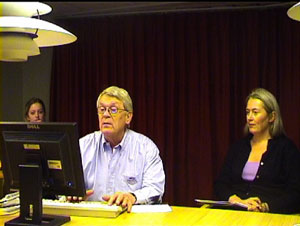
This issue in pdf Archive: Next issue: Next Special theme: |
|
|||
"What did the others do?" - Recommending by Visualising Fellow Travellersby Åsa Rudström and Petra Fagerberg In real life, humans are social creatures, interested in the behaviour of others. We follow trails, we go where the action seems to be, and we buy the same kinds of things that our friends buy. The SOCIFER project at SICS investigated the effects of transferring some social mechanisms into the design of an on-line travel booking system. By getting statistical information on fellow travellers' bookings, users could see what others were doing and could use this as a basis for their own choices. Recommendation is one way in which social functionality is exploited in interactive systems, eg on the Web. The recommendation may come from a specific person (such as a movie reviewer), be compiled from sales records (such as top-ten lists), or be based on the collective behaviour of many users (collaborative recommendation). An example of the latter is the 'people who bought this also bought that' functionality of Amazon.com. The most prominent trend in recommender systems is to suggest what item to choose, or what action to take. However, for recommendations to really work it is crucial that the reasoning behind the recommendation be understood. When a friend recommends a book to you, you know that the recommendation is based on your friend's knowledge about you. A top-ten list is based on statistics, but if a booking system recommends that you add a cabin to your ferry ticket booking, why is this suggested to you? In a joint project with Stena Line, an international transport and travel service company and one of the world's largest ferry operators, we explored the approach of visualising the collaborative data, leaving it to the user to decide on a course of action. In other words, instead of the letting the system make a suggestion, users were expected to create recommendations themselves based on the background data. We developed and tested a prototypical social interface component, displaying fake but realistic statistical booking information concerning a limited number of ferry departures. A qualitative laboratory study was performed. Seven study subjects were given two ticket-booking tasks, one at a time, in varying order. The tasks were presented as mini-scenarios, giving most but not all of the information needed to accomplish the task. Subjects were minimally instructed and asked to 'think aloud'. Observations were made on user behaviour, and in particular when and to what extent the social component was noticed and used.
All subjects were overwhelmingly positive towards the idea of supporting the on-line booking process with relevant social information. We found strong evidence that subjects did use the statistics as a basis for their selections in the on-line booking. For example: A: "What about the other departure then? Not very many children, lots of noisy people, nah, we'll take the early boat." We set out to test the hypothesis that an on-line booking system would benefit from making other people's bookings visible in the form of statistics. In conclusion, the results from the study support this hypothesis. Link:
Please contact: |
|||


